Difference between revisions of "ANLY482 AY2016-17 T2 Group7: Exploratory Data Analysis"
Yx.lim.2013 (talk | contribs) m |
Yx.lim.2013 (talk | contribs) |
||
| Line 39: | Line 39: | ||
<!-- Start Information --> | <!-- Start Information --> | ||
| − | <div style="background:#307FBB; line-height:0.3em; font-family:sans-serif; font-size:120%; border-left:#bbdefb solid 15px;"><div style="border-left:#fff solid 5px; padding:15px;"><font color="#fff"><strong> | + | <div style="background:#307FBB; line-height:0.3em; font-family:sans-serif; font-size:120%; border-left:#bbdefb solid 15px;"><div style="border-left:#fff solid 5px; padding:15px;"><font color="#fff"><strong>Test Case I: Data Analysis</strong></font></div></div> |
| − | + | After processing the data, we tested it against 2 test cases, namely the data analysis of the search counts and text analytics of 2 databases, Euromonitor and Lawnet. The first test case is as follows: | |
| − | + | Tools: Tableau 10.1, SAS Enterprise Guide 7.1 (64-bit) | |
| − | |||
| − | |||
| − | |||
| − | |||
| − | |||
| − | |||
| − | |||
| − | |||
| − | |||
| − | |||
| − | |||
| − | |||
| − | |||
| − | |||
| − | |||
| − | |||
| − | + | For the 12 months’ worth of data (2016_processed_log.csv)<br/> | |
| − | |||
{| class="wikitable" | {| class="wikitable" | ||
| − | |||
| − | |||
| − | |||
|- | |- | ||
| − | | | + | ! Parameters !! Description !! Example |
| − | | | + | |- |
| − | + | | libuser_ID || Student ID hashed by the SMU Library so as to protect the identity of users || 65ff93f70ca7ceaabcca62de3882ed1633bcd14ecdebbe95f9bd826bd68609ba | |
| − | + | |- | |
| + | | libsession_ID || Each session is identified by a unique ID, which corresponds to 1 session by a single user || tDU1zb0CaV2B8qZ | ||
| + | |- | ||
| + | | search_database || The e-resources database which the search query is searched on || heinonline | ||
| + | |- | ||
| + | | timestamp || Date and time when the search query is executed by the user in the format: DD/MMM/YYYY HH:MM:SS || 01/Jan/2016:00:01:36 | ||
|- | |- | ||
| − | | | + | | search_query || Search query that was being searched by the user || (The%20Great%20Peace) |
| − | | | + | |} |
| − | + | Student Information Data (Student User List) | |
| − | |||
| − | |||
| − | |||
| − | |||
| − | |||
| − | |||
| − | |||
| − | |||
| − | |||
| − | |||
{| class="wikitable" | {| class="wikitable" | ||
|- | |- | ||
| − | ! | + | ! Original Parameters || New Parameters !! Description !! Example |
|- | |- | ||
| − | | | + | | email || libuser_ID || Student ID hashed by the SMU Library so as to protect the identity of users || 65ff93f70ca7ceaabcca62de3882ed1633bcd14ecdebbe95f9bd826bd68609ba |
|- | |- | ||
| − | | | + | | Statistical Category 1 || school || This indicates the school that the user is from || School of Law |
|- | |- | ||
| − | | | + | | Statistical Category 2 || programme_type || This indicates the specific programme the user is undertaking || Bachelor of Laws |
|- | |- | ||
| − | | | + | | Statistical Category 3 || admission_year || This indicates the year which the user is admitted into SMU || AY_2013 |
|- | |- | ||
| − | | | + | | Statistical Category 4 || graduating_year || This indicates the year which the user is graduated from SMU || GY_2017 |
|- | |- | ||
| − | | | + | | User Group || education_level || This indicates which level of education the user is in, typically Masters or Bachelors programme || UNDERGRADUATE STUDENTS |
| − | |||
| − | |||
|} | |} | ||
| − | + | With the assumption of each unique session ID and user ID along with each database being one search query, we group the data set based on these 3 variables. | |
| + | |||
| + | The search count is extracted from the log data and proves to be valuable in understanding the search querying behaviors of SMU students throughout the year of 2016. Trends and peaks are observed when the number of searches are broken down by months. | ||
| + | <br/> | ||
| + | |||
| + | <div style="color:#212121;"> | ||
| + | [[File:BJJ1.png|700px]]<br/> | ||
| + | ''Chart 1: Overall Search Counts by Month for All Users''<br/> | ||
| + | |||
| + | [[File:Overall search by existing students.png|700px]]<br/> | ||
| + | ''Chart 1.1: Overall Search by Month for Existing Students''<br/> | ||
| + | |||
| + | [[File:Search counts by existing students during academic weeks1.png|1040px]]<br/> | ||
| + | ''Chart 1.2: Search Count by Existing Students during Academic Weeks''<br/> | ||
| + | |||
| + | [[File:user_group_search_counts.jpg|300px]]<br/> | ||
| + | ''Chart 2: User Group Search Counts''<br/> | ||
| − | + | [[File:others_search_counts.jpg|300px]]<br/> | |
| + | ''Chart 3: Search Count of 'Others'''<br/> | ||
| − | + | <u>Analysis: Awareness of the number of searches throughout the year </u> <br/> | |
| + | There is great variation in the number of searches across the span of a year, and these searches on the EZproxy are contributed by students - Undergraduate, Masters, PhD and others (international exchange, local exchange, visiting students). As the users of the EZproxy site are students of Singapore Management University, the spike in the number of searches can be seen during the months of the regular Terms (Term 1 and 2) - January to March and Mid-August to November respectively. | ||
| − | From Chart 1.1, we decided to generate another chart showing how students search throughout the weeks in academic terms. We observed that the peaks in the regular terms, Terms 2 and 1, occur during Week 8, which is the recess week. This could be because that majority of the students start their research during recess week. | + | In Chart 1, we could potentially identify the start and end of the 2 regular Terms just by observing where the number of searches experience a gradual dip. The overall trend of the number of searches forms the shape of a jagged mountain for both Terms, thus the start and ends of the mountains fall around the start and ends of the Terms. From Chart 1.1, we decided to generate another chart showing how students search throughout the weeks in academic terms. We observed that the peaks in the regular terms, Terms 2 and 1, occur during Week 8, which is the recess week. This could be because that majority of the students start their research during recess week. |
| − | Next, we observed that there is a decrease in the number of searches in the weeks following the recess week (Week 8) and then we noticed there is an unusual increase in the number of searches again in Week 14, which is the study week. This same trend can be seen on both Term 2 & 1. We believe that this increase in the number of searches could be due to the students performing searches as they revise for their final examinations. | + | Next, we observed that there is a decrease in the number of searches in the weeks following the recess week (Week 8) and then we noticed there is an unusual increase in the number of searches again in Week 14, which is the study week. This same trend can be seen on both Term 2 & 1. We believe that this increase in the number of searches could be due to the students performing searches as they revise for their final examinations. <br/> |
| − | + | <u> Discussion: </u> <br/> | |
| + | We want to understand the number of searches throughout the year and see if there are any observable trends. Thus, we initiated the breakdown of the number of searches by months, to have a better look at where the peak periods are. | ||
| − | + | The sponsors will be able to use these results to know the amount of load their server must be ready to handle at different periods of the year, especially during the undergraduate semesters. Furthermore, such results would be very useful for the sponsors in deciding at which period of the year should they organize library training to train the users in effective academic search querying which is vastly different to the generic search querying methods they typically perform on search engines such as Google. <br/> | |
| − | |||
[[File:Chart4.png|1040px]]<br/> | [[File:Chart4.png|1040px]]<br/> | ||
| Line 130: | Line 121: | ||
[[File:Bjj6.png|1040px]]<br/> | [[File:Bjj6.png|1040px]]<br/> | ||
''Chart 6: Search Count by Days for Term 2: Jan-March 2016''<br/> | ''Chart 6: Search Count by Days for Term 2: Jan-March 2016''<br/> | ||
| − | |||
| − | |||
| − | |||
[[File:Chart5.png|1040px]]<br/> | [[File:Chart5.png|1040px]]<br/> | ||
| Line 140: | Line 128: | ||
''Chart 8: Chinese New Year in 2016''<br/> | ''Chart 8: Chinese New Year in 2016''<br/> | ||
| − | |||
| − | |||
| − | |||
| − | |||
| − | |||
| − | |||
| − | |||
| − | |||
| − | |||
| − | |||
| − | |||
| − | |||
| − | |||
| − | |||
| − | |||
| − | |||
| − | |||
| − | |||
| − | |||
| − | |||
| − | |||
| − | |||
| − | |||
| − | |||
| − | |||
[[File:Percent_of_Search_Counts_by_Degrees_in_Weekends.png|800px]]<br/> | [[File:Percent_of_Search_Counts_by_Degrees_in_Weekends.png|800px]]<br/> | ||
Revision as of 13:42, 20 April 2017
After processing the data, we tested it against 2 test cases, namely the data analysis of the search counts and text analytics of 2 databases, Euromonitor and Lawnet. The first test case is as follows: Tools: Tableau 10.1, SAS Enterprise Guide 7.1 (64-bit)
For the 12 months’ worth of data (2016_processed_log.csv)
| Parameters | Description | Example |
|---|---|---|
| libuser_ID | Student ID hashed by the SMU Library so as to protect the identity of users | 65ff93f70ca7ceaabcca62de3882ed1633bcd14ecdebbe95f9bd826bd68609ba |
| libsession_ID | Each session is identified by a unique ID, which corresponds to 1 session by a single user | tDU1zb0CaV2B8qZ |
| search_database | The e-resources database which the search query is searched on | heinonline |
| timestamp | Date and time when the search query is executed by the user in the format: DD/MMM/YYYY HH:MM:SS | 01/Jan/2016:00:01:36 |
| search_query | Search query that was being searched by the user | (The%20Great%20Peace) |
Student Information Data (Student User List)
| Original Parameters | New Parameters | Description | Example |
|---|---|---|---|
| libuser_ID | Student ID hashed by the SMU Library so as to protect the identity of users | 65ff93f70ca7ceaabcca62de3882ed1633bcd14ecdebbe95f9bd826bd68609ba | |
| Statistical Category 1 | school | This indicates the school that the user is from | School of Law |
| Statistical Category 2 | programme_type | This indicates the specific programme the user is undertaking | Bachelor of Laws |
| Statistical Category 3 | admission_year | This indicates the year which the user is admitted into SMU | AY_2013 |
| Statistical Category 4 | graduating_year | This indicates the year which the user is graduated from SMU | GY_2017 |
| User Group | education_level | This indicates which level of education the user is in, typically Masters or Bachelors programme | UNDERGRADUATE STUDENTS |
With the assumption of each unique session ID and user ID along with each database being one search query, we group the data set based on these 3 variables.
The search count is extracted from the log data and proves to be valuable in understanding the search querying behaviors of SMU students throughout the year of 2016. Trends and peaks are observed when the number of searches are broken down by months.
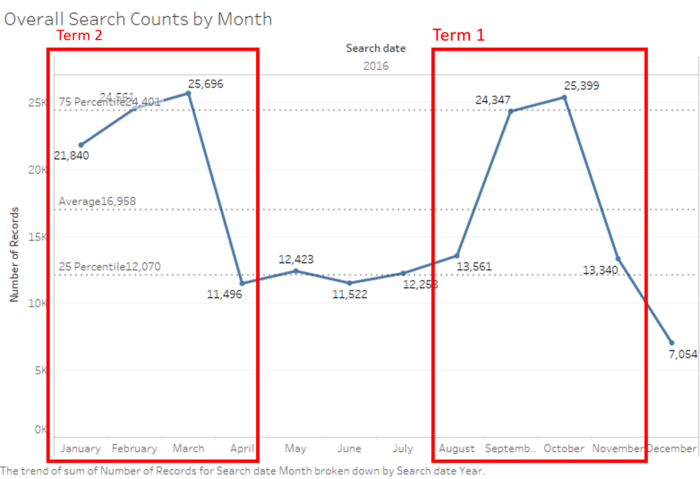
Chart 1: Overall Search Counts by Month for All Users
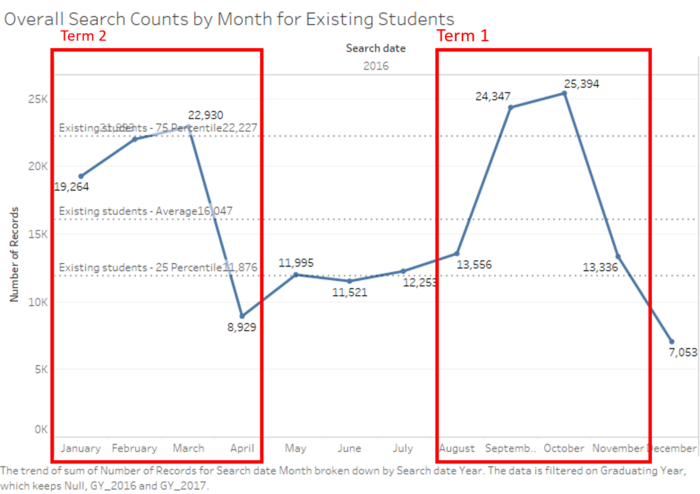
Chart 1.1: Overall Search by Month for Existing Students

Chart 1.2: Search Count by Existing Students during Academic Weeks
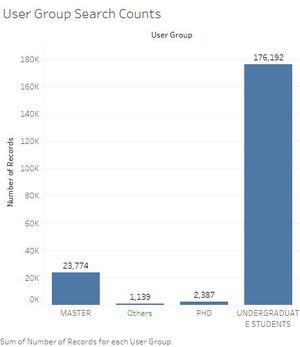
Chart 2: User Group Search Counts
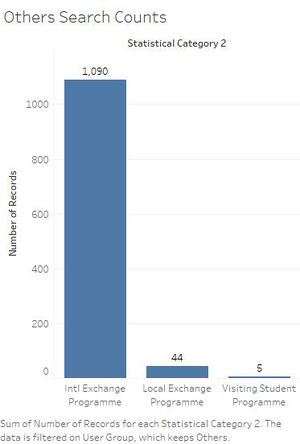
Chart 3: Search Count of 'Others'
Analysis: Awareness of the number of searches throughout the year
There is great variation in the number of searches across the span of a year, and these searches on the EZproxy are contributed by students - Undergraduate, Masters, PhD and others (international exchange, local exchange, visiting students). As the users of the EZproxy site are students of Singapore Management University, the spike in the number of searches can be seen during the months of the regular Terms (Term 1 and 2) - January to March and Mid-August to November respectively.
In Chart 1, we could potentially identify the start and end of the 2 regular Terms just by observing where the number of searches experience a gradual dip. The overall trend of the number of searches forms the shape of a jagged mountain for both Terms, thus the start and ends of the mountains fall around the start and ends of the Terms. From Chart 1.1, we decided to generate another chart showing how students search throughout the weeks in academic terms. We observed that the peaks in the regular terms, Terms 2 and 1, occur during Week 8, which is the recess week. This could be because that majority of the students start their research during recess week.
Next, we observed that there is a decrease in the number of searches in the weeks following the recess week (Week 8) and then we noticed there is an unusual increase in the number of searches again in Week 14, which is the study week. This same trend can be seen on both Term 2 & 1. We believe that this increase in the number of searches could be due to the students performing searches as they revise for their final examinations.
Discussion:
We want to understand the number of searches throughout the year and see if there are any observable trends. Thus, we initiated the breakdown of the number of searches by months, to have a better look at where the peak periods are.
The sponsors will be able to use these results to know the amount of load their server must be ready to handle at different periods of the year, especially during the undergraduate semesters. Furthermore, such results would be very useful for the sponsors in deciding at which period of the year should they organize library training to train the users in effective academic search querying which is vastly different to the generic search querying methods they typically perform on search engines such as Google.

Chart 4: Dip in Weekends for Term 2: Jan-March 2016

Chart 5: Dip in Weekends for Term 1: Aug-Nov 2016

Chart 6: Search Count by Days for Term 2: Jan-March 2016

Chart 7: Search Count by Days for Term 1: Aug-Nov 2016

Chart 8: Chinese New Year in 2016
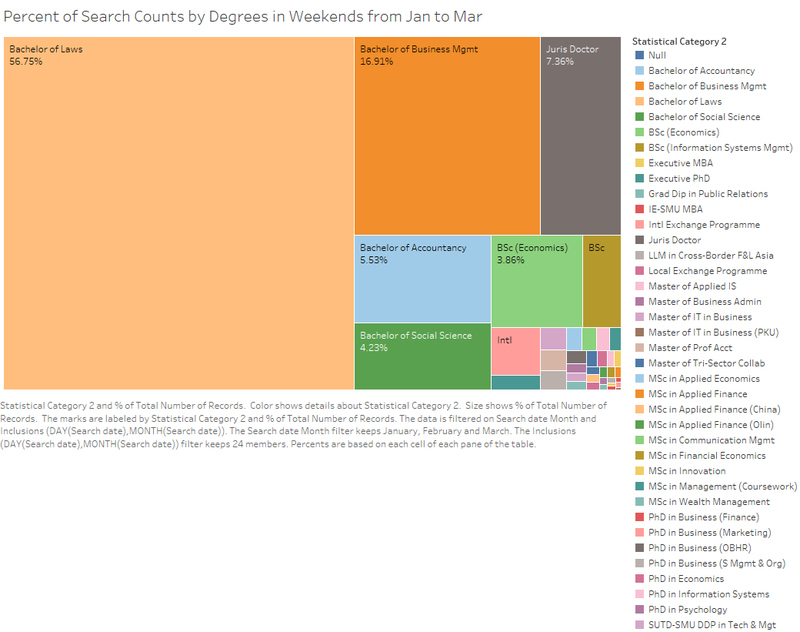
Chart 9: Percentage of Search Counts by Degrees in Weekends for Term 2: Jan-March 2016
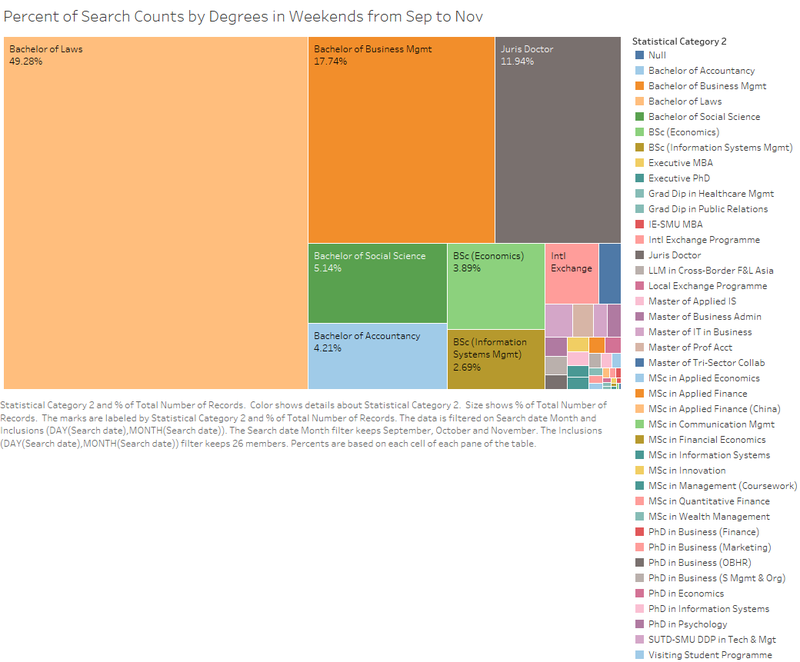
Chart 10: Percentage of Search Counts by Degrees in Weekends for Term 1: Sep to Nov 2016
| Subject Matter: | Understanding the percentage of searches contributed by students across their Degrees during weekends |
| Thought Process: | We want to dive deeper into the analysis of weekend searches and find out who are the ones still contributing to it, despite the dip in number of weekend searches. |
| Analysis: | In Chart 9, we noticed that 56.75% of searches were done by students enrolled in the Bachelor of Laws programme, which occupies a majority of the total number of searches performed on weekends. Additionally, 16.91% of searches were done by students from Bachelor of Business Management and 7.36% from the Juris Doctor programme.
One of the possible conclusions from this observation is that students enrolled in the Law field (Bachelor of Laws & Juris Doctor programme) do not typically stop performing searches and/or stop researching simply because it is the weekends. In addition to that, students in the Bachelor of Business Management programme contributes significantly to the number of searches on weekends too, perhaps due to the nature of the programme which is research-intensive. This is in contrast to students from other non-research intensive programmes such as Bachelor of Science (Information Systems) at 1.64% of total number of searches. In Chart 10, we can observe that the abovementioned trend is consistent for students in the Bachelor of Laws, Bachelor of Business Management and Juris Doctor. Thus, our trend analysis holds consistent for both Terms 1 and 2. |
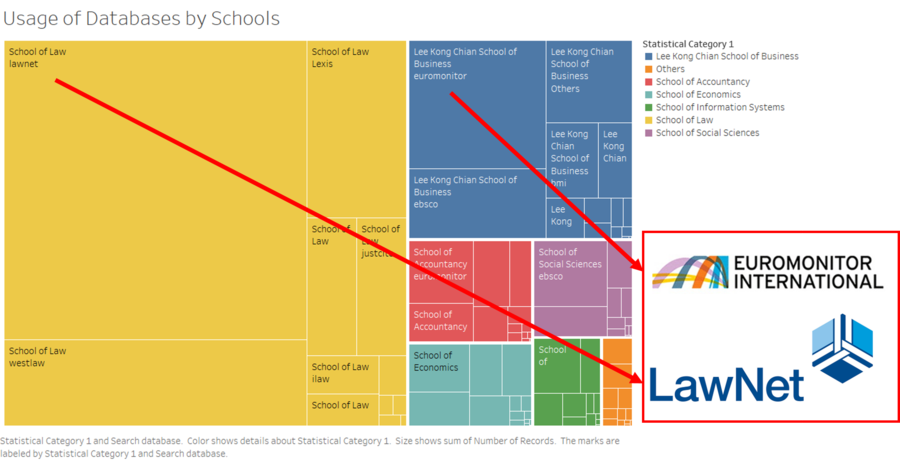
Chart 11: Usage of Database by Schools